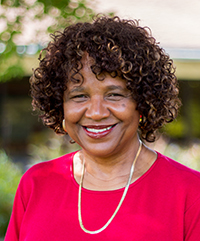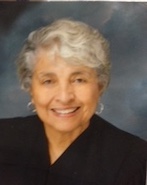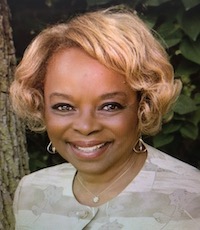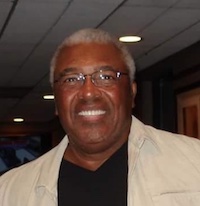AACHM Oral History: Sandra Harris
 Sandra Harris was born in 1952 in West Virginia, where her father was a coal miner. Her family moved to Ann Arbor when she was in second grade. Harris remembers being on the homecoming court at Pioneer High School and participating in student-led marches during the late 1960s. She received her bachelor’s, master’s and doctorate degrees from Eastern Michigan University. She was a school administrator in the Ann Arbor Public Schools as well as other districts. In addition to her service as an educator, she was also a longtime caretaker for her nephew and her mother.
Sandra Harris was born in 1952 in West Virginia, where her father was a coal miner. Her family moved to Ann Arbor when she was in second grade. Harris remembers being on the homecoming court at Pioneer High School and participating in student-led marches during the late 1960s. She received her bachelor’s, master’s and doctorate degrees from Eastern Michigan University. She was a school administrator in the Ann Arbor Public Schools as well as other districts. In addition to her service as an educator, she was also a longtime caretaker for her nephew and her mother.
AACHM Oral History Excerpt: Audrey Monagan
Audrey Monagan was born in Ann Arbor in 1941, and grew up in a close-knit, predominantly black neighborhood on North Fifth Ave. She remembers attending Bethel AME Church with her grandparents, spending time at the Dunbar Community Center, and helping raise her younger siblings. She attended Jones School and Pioneer High School before working for General Motors, where she was an inspector for eighteen years. Mrs. Monagan has been married to her second husband, Philip, for 48 years.
Linda Diane Feldt (and Aisling)
Video extra from the feature-length documentary Welcome to Commie High from 7 Cylinders Studio.
Arwulf Arwulf At WCBN
Video extra from the feature-length documentary Welcome to Commie High from 7 Cylinders Studio.
JCC Conversations | Sue Shooner – Girls Group
How retired automobile executive Susan Schooner is helping young women reach their potential—and how that work has helped her find herself.
JCC Conversations | Nurit Gery, Christina, Te’ena and Hussein
Guest speaker Nurit Gery, director of Givat Haviva International School in northern Israel along with students Christina, Te’ena and Hussein from GHIS which is a coed boarding high school that brings together promising young students from diverse communities and varying economic backgrounds. Over three years they train to become leaders for cross-cultural cooperation and conflict resolution.
Their stories are fascinating and will give you hope.
AACHM Oral History Excerpt: Mary Wheeler McDade
 Mary McDade was born in Columbia, South Carolina in 1939, but grew up in Ann Arbor. Her parents Albert and Emma Wheeler were active in local politics and civil rights. As a college student, McDade helped found the University of Michigan chapter of the NAACP. She moved to Peoria, Illinois with her husband Joe Billy McDade in 1963. After raising four children, she built a career in law. McDade graduated from the University of Illinois College of Law and she has been a justice of the Illinois Appellate Court since 2000.
Mary McDade was born in Columbia, South Carolina in 1939, but grew up in Ann Arbor. Her parents Albert and Emma Wheeler were active in local politics and civil rights. As a college student, McDade helped found the University of Michigan chapter of the NAACP. She moved to Peoria, Illinois with her husband Joe Billy McDade in 1963. After raising four children, she built a career in law. McDade graduated from the University of Illinois College of Law and she has been a justice of the Illinois Appellate Court since 2000.
AACHM Oral History: Patricia Manley
 Patricia Ashford Manley was born in 1945 in Ann Arbor, and she was raised by her mother. She remembers attending Jones Elementary School and trying out for cheerleading at Ann Arbor High School. Manley graduated from Western Michigan University in 1970 and later earned her master’s in counseling from Eastern Michigan University. She worked as a teacher, cheerleading coach, and guidance counselor at Huron High School for thirty-one years, and was principal of Thurston Elementary School for ten years. She and her husband Lamont Manley enjoy traveling and going to concerts together. They have been married for 43 years.
Patricia Ashford Manley was born in 1945 in Ann Arbor, and she was raised by her mother. She remembers attending Jones Elementary School and trying out for cheerleading at Ann Arbor High School. Manley graduated from Western Michigan University in 1970 and later earned her master’s in counseling from Eastern Michigan University. She worked as a teacher, cheerleading coach, and guidance counselor at Huron High School for thirty-one years, and was principal of Thurston Elementary School for ten years. She and her husband Lamont Manley enjoy traveling and going to concerts together. They have been married for 43 years.
AACHM Oral History: Mike Bass
 Michael Thomas Bass was born in 1945 to Thomas and Louise Bass. His parents–a doctor and a teacher–were influential members of Ypsilanti’s Black community. Bass excelled in football, basketball, and track. He was senior class president of Ypsilanti High School in 1963. He received a BA in Education from the University of Michigan. Bass is best known for playing in the National Football League for the Washington Commanders (formerly Redskins) from 1969 to 1975. After retiring from the NFL, Bass ran a resort in the Bahamas. He and his wife Rosita now reside in Florida and they have two daughters, Kimberly and Louise.
Michael Thomas Bass was born in 1945 to Thomas and Louise Bass. His parents–a doctor and a teacher–were influential members of Ypsilanti’s Black community. Bass excelled in football, basketball, and track. He was senior class president of Ypsilanti High School in 1963. He received a BA in Education from the University of Michigan. Bass is best known for playing in the National Football League for the Washington Commanders (formerly Redskins) from 1969 to 1975. After retiring from the NFL, Bass ran a resort in the Bahamas. He and his wife Rosita now reside in Florida and they have two daughters, Kimberly and Louise.
Community Ensemble Theater (CET) - Extended Scene
An extended scene from the feature-length documentary Welcome to Commie High from 7 Cylinders Studio, featuring Quinn Strassel, Clarence Collins III, Betsy King, Evelyn Collins, Chris Tabaczka & Sebastian Wreford.